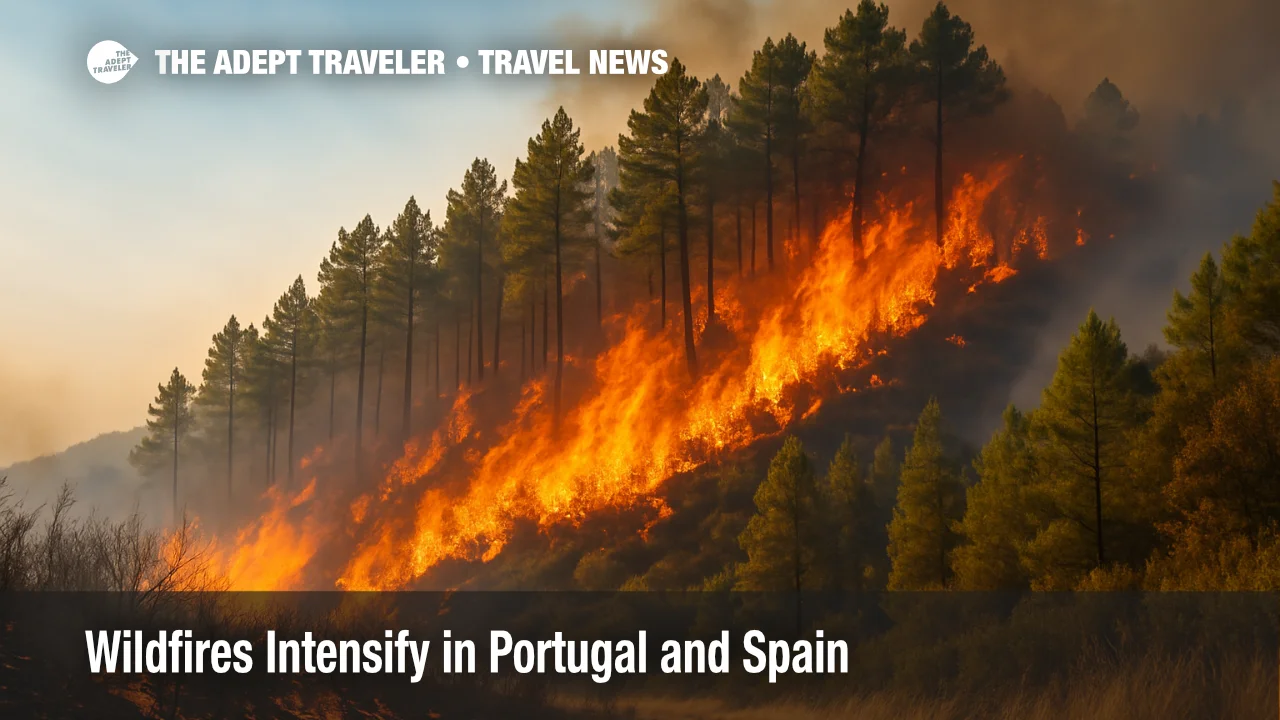Wildfires Intensify in Portugal and Spain

Northern Portugal and central Spain endured their fiercest wildfire surge of the season overnight. Firefighters confronted at least a dozen large blazes as bone-dry forests, gusty winds, and triple-digit heat combined to accelerate fire spread. Emergency managers in both countries have deployed extra ground crews and water-dropping aircraft, while local officials issued evacuation orders and warned travelers to avoid affected corridors. Meteorologists forecast another stretch of extreme heat-temperatures near 102 °F and low humidity-that could fan new ignitions through the weekend. With tourist flows at their summer peak, authorities stress vigilance, route flexibility, and adherence to safety advisories.
Key Points
- Why it matters: Intensifying wildfires threaten popular summer travel routes, forcing evacuations and road closures.
- Fire crews tackled at least 12 major blazes overnight-the largest wave so far this year.
- Hot, dry, and windy conditions in Portugal's Norte and Spain's Castilla y León regions heighten fire risk.
- Evacuations ordered in Vila Real, Braga, Guarda, Salamanca, and Ávila provinces.
- Travelers should monitor official alerts, expect smoky conditions, and allow extra transit time.
Snapshot
Fire behavior escalated rapidly after sunset on July 30, when several lightning-sparked and rekindled fires expanded across mountainous terrain. In Portugal, flames encircled villages near Vila Real and Guarda, compelling overnight evacuations and cutting regional highways for several miles. Across the border, Spain's Castilla y León recorded multiple simultaneous ignitions, including a fast-moving front outside Ávila that briefly threatened the A-50 motorway. More than 1 800 Portuguese personnel and 1 200 Spanish counterparts-supported by 24 aircraft-worked through the night, establishing containment lines and protecting homes. Dense smoke reduced visibility on key tourism arteries such as Spain's N-110 and Portugal's A24, delaying early-morning traffic and rail services.
Background
Portugal and Spain share one of Europe's most fire-prone corridors, where prolonged drought and aggressive pine and eucalyptus cultivation create vast fuel reserves. Both countries lost extensive forestland to catastrophic fires in 2017 and 2022, prompting investments in prevention, early-warning networks, and joint aerial fleets. Despite these efforts, 2025 has unfolded as the region's third-hottest summer on record, with less than four inches of rain since May along the Douro valley. The Portuguese Institute for Sea and Atmosphere (IPMA) placed most northern districts under "Maximum" rural fire danger on July 31, while Spain's national Civil Protection agency activated Level 1 response protocols for Castilla y León. The latest provisional tallies show Portugal suffering more than 195 square miles of burned area this season, while Spain reports 265 square miles, both trending above five-year averages.
Latest Developments
Firefronts Push Toward Communities
Portugal's biggest concern centers on a 7-mile fire line near Montalegre, Braga District. Winds gusting to 25 miles per hour forced crews to retreat overnight before regrouping at dawn to defend three hamlets and a hydro-electric substation. Helicopters resumed water drops at first light, but rugged topography continues to complicate access. In Spain, a similarly aggressive blaze northwest of Ávila jumped containment twice, torching 4 000 acres of pine scrub. Firefighters established a six-mile bulldozer break along the Sierra de Ávila ridgeline to shield nearby villages from embers carried on upslope winds.
Evacuations and Travel Disruptions
Evacuation shelters opened in the Portuguese towns of Boticas and Chaves, providing cots, meals, and medical support for roughly 400 residents. Spain's Civil Guard escorted 280 people from rural properties near Navaluenga, Ávila Province, while regional rail operator Renfe suspended service between Ávila and Salamanca until air quality improves. The Portuguese rail line between Peso da Régua and Vila Pouca de Aguiar remains closed for track inspections. Highway authorities advise motorists to reroute via the A-23 and A-55 where possible and to expect reduced speeds in smoke-affected zones.
Analysis
The overnight escalation underscores a growing climate-driven threat to Iberian tourism. Decades-long warming trends have shifted Portugal's wildfire season forward by nearly a month and expanded Spain's high-risk window well into October. Higher temperatures accelerate vegetation desiccation, turning traditional pasturelands into tinderboxes that ignite easily from dry lightning or human sparks. Rural depopulation compounds the challenge by reducing volunteer fire-watch capacity and leaving vast tracts unmanaged. Although Portugal and Spain coordinate aerial firefighting assets under the EU Civil Protection Mechanism, resource bottlenecks appear when multiple large incidents erupt simultaneously-as seen this week. For travelers, wildfire risk now ranks alongside strikes and extreme heat as a key summer-planning variable. Flexible itineraries, robust travel insurance (covering wildfire-related delays), and real-time alert apps are increasingly indispensable. Destination marketers, meanwhile, must balance safety messaging with economic imperatives, ensuring transparent communication about local conditions while promoting unaffected areas. Long term, sustainable forest management-thinning dense plantations, restoring native hardwood mosaics, and reinforcing rural economies-offers the most durable path to reducing fire intensity. Without such adaptation, the Iberian Peninsula's tourism backbone may face recurrent disruptions that erode traveler confidence.
Final Thoughts
As wildfires intensify in Portugal and Spain, travelers should remain alert, heed evacuation orders, and check official bulletins before setting out. Continued extreme heat through early August suggests additional flare-ups are possible, making flexibility and preparedness essential for anyone touring the Iberian interior this summer. Staying informed and adapting plans quickly can help ensure safety and minimize the impact of these increasingly frequent events as wildfires intensify.
